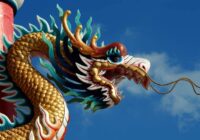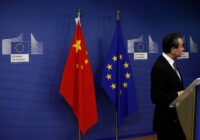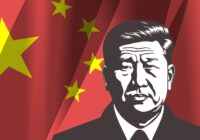Barack Obama failed to execute an economic and military pivot to Asia. Will Donald Trump pick up the fumble and run with it?
James Mattis visited Asia this month on his first foreign trip as the new head of the Pentagon. It was less a get-acquainted visit than a damage control tour. His boss, President Donald Trump, had threatened to escalate tensions with China and prevent North Korea from launching a nuclear-capable ICBM, or intercontinental ballistic missile. He’d accused Japan of currency manipulation. He wanted both Tokyo and Seoul to pay more for their alliance with America. He’d unceremoniously pulled out of a free-trade agreement—the Trans-Pacific Partnership (TPP)—that the United States had previously gone all out to promote.
Like the good cop who comes in to soften up a suspect that’s been abused by the bad cop, Mattis made many reassuring statements on his trip and even directly contradicted his administration. Allies were paying their share, he said. The US military would stand firm behind Japan and South Korea. And diplomacy, not military force, was the way to solve disputes like those in the South China Sea.
The question is not which cop is in charge of US foreign policy (answer: both are in charge). The underlying question is what the administration ultimately wants for Asia. It can stick, more or less, with the status quo. Or it can finish what the Obama administration tried and failed to do: shift the emphasis of US military and economic policy away from the Middle East and toward Asia.
During its two terms, the Obama administration managed to shift some of the emphasis of US foreign policy toward Asia, the wealthiest and most heavily militarized region of the world. The United States continued to encourage Japan to break out of the restraints of the “peace constitution.” It relocated some Marines from the controversial Futenma military base on Okinawa to other places in the region. It solidified US relations with Vietnam on the basis of mutual fear of China. It persuaded the Philippines to welcome back US military forces at five permanent installations on the island chain. It overcame initial South Korean reluctance to deploy the THAAD missile defense system.
These developments, which certainly reinforced the status quo, did not add up to a pivot. Like its two predecessors, the Obama administration was not able to “solve” the Okinawa problem by having a replacement facility built for the Futenma Marine Air Force base. It was not able to redirect a substantial portion of US military forces from the Middle East and Europe to the Pacific. It could not ultimately conclude the TTP and compete more effectively with China in the regional economy. Despite its explicit desire to do cut its losses in Afghanistan and Iraq, the Obama administration was still pinned down in both countries. The fight against the Islamic State had replaced al-Qaeda and the Taliban as the chief focus of US military attention.
 According to some of his campaign rhetoric, Donald Trump was interested not in a Pacific pivot, but rather a homeland pivot. He emphasized “America first,” which suggested that he might reduce US military footprint overseas in order to direct resources into rebuilding US infrastructure and industry.
According to some of his campaign rhetoric, Donald Trump was interested not in a Pacific pivot, but rather a homeland pivot. He emphasized “America first,” which suggested that he might reduce US military footprint overseas in order to direct resources into rebuilding US infrastructure and industry.
But even before he took office, Trump moved quickly to dispel those illusions. He took a phone call from the Taiwanese president, a break with tradition that indicated a new toughness toward Beijing. He began to prepare the groundwork for a major increase in military spending, as much as $1 trillion over 10 years, which the Republican Congress is eager to support.
CONFRONTING CHINA
The Trump administration views China as the only serious threat to American power in the world. Although previous US governments have eventually settled on a congagement approach to Beijing—a mixture of military containment and economic engagement—the Trump administration seems interested only in confrontation. For his part, President Xi Jinping seems to be positioning China as the country that will guide the global economy in the absence of a newly protectionist United States.
It’s possible that Trump, ever the businessman, will come to realize like all recent US presidents that China is too big to ignore and too powerful to antagonize. Even George W. Bush found common ground with Beijing, particularly on counterterrorism. But others in the Trump administration, like Strategic Advisor Steve Bannon, see China as a civilizational threat—officially atheist, non-white, committed to a cross between centralized economic control and crony capitalism. Bannon has no problem partnering with authoritarian governments. But China falls outside the conservative, Christian, Caucasian coalition that Bannon wants to build worldwide.
With a larger military, a Republican-controlled Congress, and a willingness to use all the power concentrated in the executive branch, Trump will likely try to complete the Pacific pivot even as he bombs the Islamic State, builds a wall along the border with Mexico and antagonizes European allies. This attempt at full-spectrum dominance may bankrupt the American economy and irreparably damage the global economy.
But Trump guided his business empire into bankruptcy an extraordinary six times in the past. Asians should obviously think twice about linking arms with such a volatile political ally and such an unreliable business partner.
*[This article was originally published by FPIF and Hankyoreh.]
The views expressed in this article are the author’s own and do not necessarily reflect Fair Observer’s editorial policy.
Photo Credit: Pete Souza
Support Fair Observer
We rely on your support for our independence, diversity and quality.
For more than 10 years, Fair Observer has been free, fair and independent. No billionaire owns us, no advertisers control us. We are a reader-supported nonprofit. Unlike many other publications, we keep our content free for readers regardless of where they live or whether they can afford to pay. We have no paywalls and no ads.
In the post-truth era of fake news, echo chambers and filter bubbles, we publish a plurality of perspectives from around the world. Anyone can publish with us, but everyone goes through a rigorous editorial process. So, you get fact-checked, well-reasoned content instead of noise.
We publish 2,500+ voices from 90+ countries. We also conduct education and training programs
on subjects ranging from digital media and journalism to writing and critical thinking. This
doesn’t come cheap. Servers, editors, trainers and web developers cost
money.
Please consider supporting us on a regular basis as a recurring donor or a
sustaining member.
Will you support FO’s journalism?
We rely on your support for our independence, diversity and quality.






